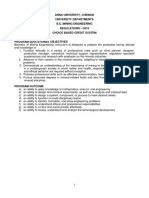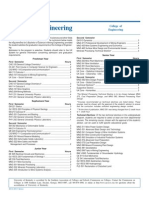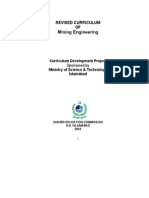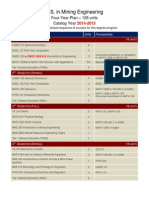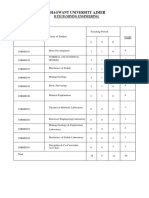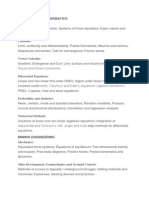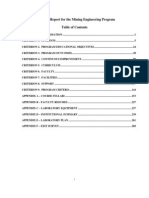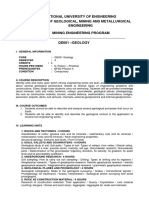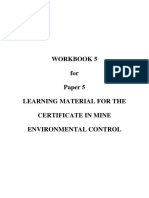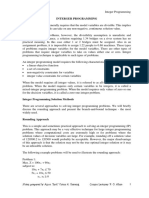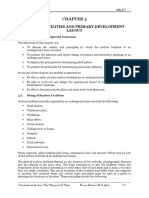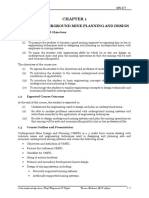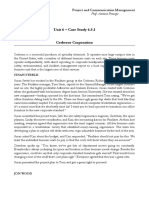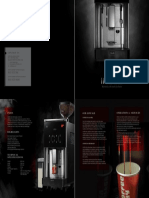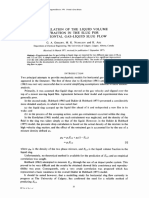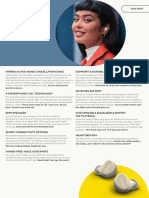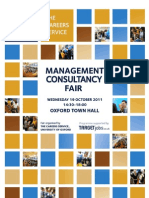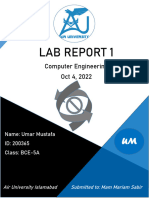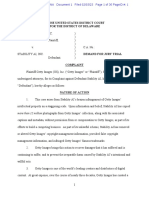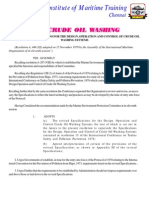Mining Engineering
The Mining Engineering Department runs both Undergraduate and Postgraduate programmes.
Aims and Objectives
The Department runs a 4-year Bachelor of Science in Mining Engineering (BSc Mining
Engineering). The programme aims at providing firm grounding in concepts of Mining
Engineering disciplines and related courses to meet the requirements of industry. The main
objectives are to:
- Train competent first degree graduates
- Prepare first degree graduates to take up jobs in industry
- Prepare candidates for higher degrees in mining and related programmes
After completing the programme, the Mining Engineer should be capable of applying science
and technology to plan, design, develop, optimise, operate and manage mining and mineral
projects anywhere in the world. He/she is trained to carry out professional duties using their
knowledge of sound environmental technology with the conscious effort to maximise returns on
investment.
Curriculum
Throughout the mining engineering programme, students take core courses in surface and
underground mining, mine planning and design, mineral deposit and ore reserve modelling,
mineral processing, mineral economics, principles of economics, mine management, rock
mechanics, rock fragmentation, operations research, economic development and planning.
These courses require a strong background in probability and statistics, mathematical analysis,
technical drawing, physical and structural geology, physical and analytical chemistry and
mineralogy and petrology, fluid mechanics, soil mechanics, land surveying, thermodynamics,
Geographical Information Systems (GIS). In order to make the engineer complete and versatile,
he/she is taught courses such as communication skill, literature in English, law of contract and
tort and entrepreneurial skills.
Career Prospects
Mining engineering graduates pursue careers in mining (surface and underground), mineral
exploration, equipment manufacturing and sales, and mineral commodity markets. They find
employment in mining companies, sales and service industries, banking and financial
institutions, exploration companies, and water engineering companies. Since human population
continues to increase with increasing complexity of taste and comfort, there need for more
minerals in the phase of competition for capital, there will also be an ever increasing need for
more Mining Engineers.
1 / 21
� Mining Engineering
Mining Engineering
Programmes Offered:
Mining Engineering BSc
Department Contact Information
Department:
Mining Engineering BSc
Phone Number: +233 (0) 362 21139
Postal Address: P O Box 237, Tarkwa, Ghana
Email Address: mn@umat.edu.gh
Website: http://www.umat.edu.gh
Programme Description
The programme is a 4-year Bachelor of Science in Mining Engineering (BSc Mining Engineering). It aims
Students take core courses in surface and underground mining, mine planning and design, mineral depo
After completing the programme, the Mining Engineer should be capable of applying science and techno
Programme Admission Requirement BSc
For admission, candidates must have:
OR SUBJECTS at Senior
1. Passes in THREE CORE 2. High
Passes
School
in the(SHS)
GCE LEVEL
ORDINARY-LEVEL
in English, Mathematics,
in English, Ma
a
WASSCE-SSSCE Conversion
2 / 21
�Mining Engineering
YEAR ONE
SEMESTER ONE
Course
Subject
No. T P C
MN 151
MN 153
MN 155
MN 157
MN 159
MN 161
MN 165
MN 167 Applied Electricity
Linear Algebra & Trigonometry
Engineering Drawing I
Communication Skills I
Introduction to Computing
Physical and Structural Geology
Elements of Mining
Basic Mechanics 2
2
2
2
1
2
2
2 2
2
2
1
3
1
1
1 3
3
3
2
2
2
2
2
Totals 15 13 19
3 / 21
�Mining Engineering
YEAR ONE
SEMESTER TWO
Course No. Subject T P
C
MN 150
MN 152
MN 163
MN 156
MN 158
MN 160
MN 162 Calculus
Strength of Materials
Physical & Analytical Chemistry
Engineering Drawing II
Communication Skills II
Mineralogy and Petrology
Applied Electronics 2
2
2
1
2
2
2 2
1
1
4
1
2
1 3
2
2
3
2
3
2
Totals 13 12 17
YEAR TWO
SEMESTER ONE
Course No. Subject
4 / 21
�Mining Engineering
MN 251
MN 255
MN 259
MN 263
MN 267
MN 269
MN 273
MN 275
MN 277 Literature in English I
Mathematical Analysis
Geology of Ghana
Mine Machinery
Thermodynamics
Mineral Processing
Mine Drainage
Field Mapping
Economic and Exploration
1 Geology
2
2
2
2
2
2
1
2 1
1
1
2
1
0
1
4
1 1
2
2
2
3
2
2
2
2
Totals 116 12 19
5 / 21
�Mining Engineering
YEAR TWO
SEMESTER TWO
Course No. Subject T P
C
MN 252
MN 254
MN 256
MN 258
MN 264
MN 270*
MN 272
MN 274 Literature in English II
Soil Mechanics
Land Surveying
Extractive Metallurgy
Fluid Mechanics
Field Trip & Technical Report Writing I
Ground Fragmentation
Alluvial & Ocean Mining 1
2
2
2
2
0
2
2 1
4
4
1
2
4
4
2 1
3
3
2
3
1
3
3
Totals 13 22 19
* Fieldtrips maybe organised in either semester but the results shall be credited only at thesecond sem
6 / 21
�Mining Engineering
YEAR THREE
SEMESTER ONE
Course No. Subject
MN 351
MN 353
MN 357
MN 359
MN 361
MN 365
MN 377
MN 376 Computer Applications
Mine Surveying
Rock Mechanics
Materials Handling
Probability & Statistics
Environment Management
Underground Mine Development
Survey Field Work 1
1
1
2
2
2
2
0 3
2
4
2
1
2
2
5 2
2
2
3
2
3
3
1
Totals 11 21 18
7 / 21
�Mining Engineering
YEAR THREE
SEMESTER TWO
Course No. Subject T P
C
MN 350
MN 352
MN 356*
MN 372
MN 374
MN 376
MN 378
MN 380
MN 382 Mineral Resource Estimation
Public Relations
Fieldtrip and Technical Report Writing II
Underground Mining Systems
Surface Mining Systems
Survey Field Work
Mine Ventilation
Petroleum Engineering
Mine Electrification 2
2
0
2
2
0
2
2
2 1
0
4
2
2
5
2
2
0 2
2
1
3
3
1
3
8 / 21
�Mining Engineering
3
2
Totals 14 15 19
* Fieldtrips maybe organised in either semester but the results shall be credited only at thesecond sem
YEAR FOUR
SEMESTER ONE
Course
Subject
No. T P C
MN 451
MN 453
MN 455
MN 457
MN 459
MN 461
MN 471 Economic Development and Planning
Mineral Project Evaluation
Geographical Information Systems (GIS)
Law of Contract and Tort
Operations Research
Principles of Economics
Mine Planning and Design 2
2
1
2
2
2
1 0
2
3
0
2
0
8 2
3
2
2
3
2
3
Totals 12 15 17
9 / 21
�Mining Engineering
YEAR FOUR
SEMESTER TWO
Course No. Subject T P
C
MN 450
MN 452
MN 454
MN 456
MN 458
MN 460 Project Work
Colloquium/Seminar
Business Entrepreneurship
Mining Laws and Regulations
Management
Instrumentation and Control
0
1
2
1
2
2 12
4
0
3
0
2 4
2
2
2
2
3
Totals 8 21 15
COURSE OUTLINE FOR
BSc. DEGREE PROGRAMME IN MINING ENGINEERING
YEAR ONE SEMESTER ONE
10 / 21
�Mining Engineering
MN 151 Applied Electricity (2, 2, 3)
Circuit laws. Circuit theorems. Electrostatics. Electromagnetics. Magnetic circuits. Inductance.
Alternating voltage and current. Signal waveforms. Introduction to transformers, Dc Machines,
Induction Machines and Synchronous Machines.
MN 153 Linear Algebra and Trigonometry (2, 2, 3)
Complex numbers: De Moivre’s theorem and its application to: (i) summation of series, (ii)
expansion of Sinnq and Cosnq in double angles, (iii) expansion of Sinnq and Cosnq in terms of
Cosq and Sinq. Vector algebra and its applications. Introduction to matrix algebra. Spherical
trigonometry.
MN 155 Engineering Drawing I (2, 2, 3)
Lettering with inclined and vertical strokes. Word spacing and compositions. General loci.
Geometrical construction of regular polygons and their solids. Descriptive geometry. Isometric
drawing. First and third angles orthographic/orthogonal projection.
MN 157 Communication Skills I (2, 1, 2)
Introduction to communication: methods and systems of communication. Pre-writing skills:
developing listening skills, note-taking and note-making, developing reading skills. Developing
writing skills (I): Sentence level (the sentence as an ordered string of words, the simple
sentence, basic sentence patterns, common grammatical errors.) Coordination and parallelism.
Ambiguity. Conventions of usage.
MN 159 Introduction to Computing (1, 3, 2)
Introduction to PCs. Windows operating system. Internet usage. Word Processing using MS
Word. Spreadsheet using MS Excel. Programming using Visual Basic Applications (VBA).
MN 161 Physical and Structural Geology (2, 1, 2)
Physical Geology – Introduction to Geology and its branches. Internal structure of the earth,
continental margins – shelf, slope, rise. Plate tectonics, earthquakes, surface geomorphology.
Principles of stratigraphy, fossils, geological time scale, radiometric methods of age
determination.
11 / 21
�Mining Engineering
Structural Geology – Primary (sedimentary and igneous) structures. Secondary structures –
foliation, folds, faults, joints, veins, lineations.
MN 165 Elements of Mining (2, 1, 2)
Basic introduction to underground and surface mining terminologies. Description of various
operations in underground and surface mining: drilling, blasting, mucking, supporting, stoping,
ventilation, benching, stripping, reclamation, including technology and equipment. Impact of
mining on the environment.
MN 167 Basic Mechanics (2, 2, 3)
Introductory concepts of engineering mechanics involving basic principles in statics and
dynamics with simple applications. Simple machines and conservation laws. Trusses.
YEAR ONE SEMESTER TWO
MN 150 Calculus (2, 2, 3)
Differentiation of algebraic and circular functions. Applications to maxima and minima. Partial
differentiation. Integration including integration by parts. Ordinary differential equations.
Laplace transforms. Beta and Gamma functions.
MN 152 Strength of Materials (2, 1, 2)
Mechanical Properties of Materials, Simple Stresses, Temperature stresses, Shear Stresses,
Torsional Shear Stresses, Beams; Shear Force and Bending Moments, Bending Stress in
Beams. Complex Stresses: Two dimensional Stress, Mohr’s stress circle.
MN 154 Physical and Analytical Chemistry (2, 1, 2)
Bonding and periodicity, chemical thermodynamics and kinematics. Solutions, electrochemistry,
introduction to metal extraction processes, steps in chemical analysis. Gravimetric and
volumetric analysis. Spectrophotometric methods of analysis. Chromatography,
Electroanalytical procedures.
MN 156 Engineering Drawing II (1, 4, 3)
12 / 21
�Mining Engineering
Using CAD Software to do the following: Sectional views and standard conventions of sectional
views. Curves of intersection of various planes and solids. Development of various solids like
cylinders and spheres. Assembly drawings from both exploded views and working drawing
views.
MN 158 Communication Skills II (2, 1, 2)
Developing writing skills (II): Paragraph level (the controlling idea, the topic sentence,
supporting sentences and developing the paragraph, transitional devices.) Developing writing
skills (III): The whole essay (forms of discourse, inductive and deductive reasoning.) Developing
writing skills (IV): Style (registers, diction, spelling and punctuation, editing).
MN 160 Mineralogy and Petrology (2, 2, 3)
Crystals description and classification. Chemical and physical properties of minerals. Brief
treatment of mode of formation of igneous, metamorphic and sedimentary rocks. Identification of
common minerals and rocks.
MN 162 Applied Electronics (2,1, 2)
Physical principles of semiconductor devices. Transistors: feedback theorem, operational
amplifier as an integrated circuit. Thyristors. Instrumentation.
YEAR TWO SEMESTER ONE
MN 251 Literature in English I (1, 1, 1)
Introduction to literary terms and devices. Specific texts: prose, drama, poetry. Vocabulary and
language use. Literature as a reflection of contemporary way of life or society (the text as
mirrors). Literature and morality (the text as examples). Literature as a form of entertainment.
African Writers Series.
MN 255 Mathematical Analysis (2, 1, 2)
Rolle’s theorem. Mean value theorems. Taylor’s theorem. Convergence of series. Power
series. Taylor’s series and Maclaurin’s series. Indeterminate forms. Differentiation, parametric
differentiation with application to plane curve.
MN 259 Geology of Ghana (2, 1, 2)
Regional geological setting and crustal rocks of West Africa. Geologic time scale and the
stratigraphic succession of the lithologies in Ghana. Economic and mineral deposits associated
13 / 21
�Mining Engineering
with the various rock units.
MN 263 Mine Machinery (2, 1, 2)
General description and classification of mine machinery. Drilling machines and accessories.
Tunneling and boring machines. Hoist and hoisting systems including duty cycle. Compressors.
MN 267 Thermodynamics (2,2,3)
Fundamental concepts. Zeroth, first and second laws of thermodynamics. Application to simple
compressible substances. Introduction to gas power cycles. Vapour power cycles and
introduction to steam plant. Reciprocating expanders and compressors. Theory of mixtures.
Introduction to reciprocating IC engines.
MN 269 Mineral Processing (2, 1, 2)
Comminution, classification, separation and concentration methods.
MN 273 Mine Drainage (2, 0, 2)
Sources and nature of mine waters. Estimation of water quantities. Methods of dewatering and
drainage. Pumping systems. Equipment selection and economics of mine drainage.
MN 275 Field Mapping (1, 4, 2)
Introduction to geological maps. Geological field mapping of parts of Tarkwa area. Drawing of
geological maps and sections. Stereonet plots. Presentation and defence of technical reports
after the field work.
MN 277 Economic and Exploration Geology (2, 1, 2)
Classification and processes of formation of mineral deposits, surface and underground
mapping methods. Use of geophysics and geochemistry in mineral exploration. Sampling,
pitting, trenching and drilling techniques in mineral exploration.
YEAR TWO SEMESTER TWO
14 / 21
�Mining Engineering
MN 252 Literature in English II (1, 1, 1)
Reading and appreciation. Literary terms. Specific texts: prose, drama, poetry. Vocabulary and
language use. Literature as a reflection of contemporary way of life or society (the text as
mirrors). Literature and morality (the text as examples). Literature as a form of entertainment.
Shakespearean and modern classics.
MN 254 Soil Mechanics (2, 4, 3)
Scope of soil mechanics. Index and engineering properties of soil. Phase relationships. Soil
improvement and applications. Shear strength of soils. Bearing capacity of soils. Lateral earth
pressure. Consolidation and settlement. Site investigation.
MN 256 Land Surveying (2, 4, 3)
Classification of surveys including chain and compass surveys. Levelling. Theodolite and
applications which include theodolite structure and adjustment, traversing, tacheometry and
tacheometric surveying. Optical Distance Measurement (ODM). Electromagnetic Distance
Measurement (EDM). Astronomy: Introduction and definition of terms, derivation of the celestial
triangle.
MN 258 Extractive Metallurgy (2, 1, 2)
Pyrometallurgy: calcinations and smelting. Hydrometallurgy: leaching and solvent extraction.
Electrometallurgy: electrowinning and electrorefining.
MN 264 Fluid Mechanics (2, 2, 3)
Properties of fluids: statics and kinematics of fluids. Euler’s equation, Bernoulli’s equation and
applications. Dynamics of fluid flow. Turbulent and laminar flow. Flow in pipes. Friction and
other losses. Open channel flow. Navier-Stokes Equation: Simple solutions. Dimensionless
analysis.
MN 270 Fieldtrip & Technical Report Writing I (0, 4, 1)
Fieldtrips to areas of interest. Students will be expected to present reports upon which they will
be assessed for their credits.
MN 272 Ground Fragmentation (2, 4, 3)
Methods of ground fragmentation: Drilling and blasting. Types of explosives and their
15 / 21
�Mining Engineering
properties. Blasthole loading methods and blast initiation. Introduction to delay blasting.
Underground and surface blast design. Environmental impact of blasting.
MN 274 Alluvial and Ocean Mining (2, 2, 3)
Characteristics of alluvial minerals. Types of alluvial deposits. Alluvial mining methods.
Hydraulic transport. Ocean uses. Geographical and legal divisions of the ocean. Marine
consolidated and unconsolidated deposits. Marine mining methods of consolidated and
unconsolidated deposits.
YEAR THREE SEMESTER ONE
MN 351 Computer Applications (1, 3, 2)
Database management using MS Access. Digitising. Contouring, volume and tonnage
calculation using Surfer. Introduction to general Mine Packages. General mine planning
packages eg. Surpac, Datamine, etc.
MN 353 Mine Surveying (1, 2, 2)
Field Astronomy: measurement to celestial bodies. Underground Surveying: correlation of
surface to underground workings, stope surveying and measurement, connection of levels,
borehole surveying.
MN 357 Rock Mechanics (1, 4, 2)
Scope of rock mechanics. Physical and mechanical properties of rocks. Rock mass structure.
Stereographic projection in rock mechanics. Rock mass classification. Underground excavations
in massive rock. Room and pillar design. Excavation support systems. Rock slope stability.
MN 359 Materials Handling (2, 2, 3)
General introduction to materials handling. Haulage systems including belt conveyors, truck
haulage and rail haulage. Excavators and loaders including shovels, FEL, LHD, tractor
scrapers, slushers/scrapers, BWE/BCE, draglines and dozers. Equipment scheduling.
Stockpiling.
16 / 21
�Mining Engineering
MN 361 Probability and Statistics (2, 1, 2)
Introduction to probability. Random variables and functions of random variables. Regression
analysis and correlation. Methods of estimation. Confidence intervals. Test of hypothesis.
Principles of Reliability.
MN 365 Environmental Management (2, 2, 3)
Mine atmosphere. Air parameters. Mine gases. Mine dust. Atmospheric air. Air pollution. Heat
in mines. Mine climate. Thermal stress environment. Thermal indices. Mine fires. Water quality
and water pollution. Environmental Impact Assessment (EIA). Use of Instruments for measuring
Air, Gases, Dust and Thermal Index.
MN 377 Underground Mine Development (2, 2, 3)
Introduction to mine development. Mine entries. Horizontal, inclined and vertical development
workings and the determination of their optimum dimensions and locations. Shaft sinking and
tunneling (drifting). Methods of excavation including boring methods. Supporting mine
excavations: types of support and materials for supporting, etc.
MN 379 Survey Field Work (0, 5, 1)
Field training during the semester. Students are required to present technical reports.
YEAR THREE SEMESTER TWO
MN 350 Mineral Resource Estimation (2, 1, 2)
Mineral resource classification. Classical estimators. Variography. Error estimation. Ordinary
Kriging.
MN 352 Public Relations (2, 0, 2)
Meaning, nature and scope of Public Relations (PR) as exhibited by its definition and distinction
from other forms of communication. Planning PR programmes. The role PR plays in
organisations and as to whether to set up a PR department or depend on the services of a PR
consultant. Media and Press Relations. Case studies.
17 / 21
�Mining Engineering
MN 356 Field Trip & Technical Report Writing II (0, 4, 1)
Fieldtrip to areas of interest. Students will be expected to present reports upon which they will
be assessed for their credits.
MN 372 Underground Mining Systems (2, 2, 3)
Stoping methods(classification and selection). Support systems. Equipment selection.
Selective mining. Unit operations. Ore transfers. Ore dilution and losses.
MN 374 Surface Mining Systems (2, 2, 3)
Types of open pit working faces and cuts. Open-pit nomenclature. Ultimate pit limit techniques
(BESR, Moving Cone and Lesch-Grossman). Stripping ratios. Unit operations: excavation,
loading and transportation. Waste dump and tailings dam design. Environmental impact of
surface mining. Land reclamation.
MN 378 Mine Ventilation (2, 2, 3)
Theoretical aspects of fluid flow. Loss of airflow. Pressure quantity survey. Loss of air
distribution. Network analysis. Natural ventilation. Ventilation of mines by fans. Mine ventilation
systems. Auxiliary ventilation systems. Booster ventilation systems.
Practicals: Airflow through ductings. Fan characteristics. Mine rescue apparatus and usage.
MN 380 Petroleum Engineering (2, 2, 3)
History of oil well drilling. Drilling techniques: conventional and unconventional drilling methods.
Rotary drilling (drill rig, drilling operations and drilling fluids). Directional drilling. Storage of
hydrocarbons. Offshore petroleum resources. Exploration platforms. Offshore exploration
drilling and well operations.
MN 382 Mine Electrification (2, 0, 2)
Distribution of power. Electric winders. Conveyors. Signalling and communication systems.
YEAR FOUR SEMESTER ONE
MN 451 Economic Development and Planning (2, 0, 2)
18 / 21
�Mining Engineering
Introduction to economic development and planning. Economic development: Theories,
strategies, problems and policies. Economic planning: Principles, techniques, strategies. Third
world and economic development and planning. The role of external finance (‘Foreign Aid’) in
development and planning of the Ghanaian economy.
MN 453 Mineral Project Evaluation (2, 2, 3)
Financial and economic analysis of mineral projects. Interest rates. Time value of money.
Evaluation criteria for mine project selection: Net Present Value (NPV), Internal Rate of Return
(IRR), Pay Back Period (PBP), Wealth Growth Rate (WGR) etc. Elements of cashflows:
revenue, capital and operating cost, taxation and royalties, depreciation. Sensitivity and risk
analyses. Cost of capital. Replacement and leverage analyses. Mine Feasibility Studies.
MN 455 Geographical Information Systems (1, 3, 2)
Need for GIS, application fields. Data input and output. Data quality and management. GIS
analysis functions and implementation.
MN 457 Law of Contract and Tort (2, 0, 2)
Law and legal system. Contract and conditions for valid contracts. Contracts and business
organisations. Abrogation of contracts.
MN 459 Operations Research (2, 2, 3)
Application of the following operations research techniques in solving relevant problems:
Linear and integer programming. Assignment and transportation problems. Decision analysis.
Project scheduling methods: CPM, PERT. Simulation techniques. Application of appropriate
computer software.
MN 461 Principles of Economics (2, 0, 2)
Introduction to microeconomics. Demand and supply and price theory. Elasticities. Economies
of scale. Optimal input combinations and cost functions. Perfect competition, monopoly,
imperfect competition (monopolistic competition, oligopoly, cartel, etc). business organization
and securities. Introduction to macroeconomics. Functions of government. Measurement of
national output and income. Money and banking. Unemployment and inflation.
MN 471 Mine Planning and Design (1, 8, 3)
19 / 21
�Mining Engineering
General Mine Planning and design principles. Surface mine planning and design. Underground
mine planning and design. Siting of surface facilities. Student Course Work.
YEAR FOUR SEMESTER TWO
MN 450 Project Work (0, 12, 4)
The project should be relevant to the mining industry and it is recommended that data and
current information from an industrial source should be used.
MN 452 Colloquium/Seminar (1, 4, 2)
The seminar on an approved subject in the form of oral presentation on scientific topic by
students.
MN 454 Business Entrepreneurship (2, 0, 2)
The basis, scope and challenges of entrepreneurship. Starting a new venture and developing
the business. Financing the new venture. Managing the new venture. Special issues (legal,
political, technical and social). Intrapreneurship. International entrepreneurship.
MN 456 Mining Laws and Regulations (1, 3, 2)
Minerals and Mining Laws. Small Scale Mining Laws. Mining, Safety and Health Regulation.
Explosives Regulations. Environmental Laws/Regulations.
MN 458 Management (2, 0, 2)
The role and functions of management including planning, organising, staffing, leading and
controlling with emphasis on supervision and leadership, communication and motivational
techniques, training and development, productivity improvement, time and conflict management
within the mining environment. Analysis of financial statements.
MN 460 Instrumentation and Control (2, 2, 3)
General Introduction to the science of measurement. Introduction to strain gauges. Advanced
strain gauge system. General discussion on open and closed loops. Translation elements and
block diagrams. Types of systems response. The theory and practice of control technology.
20 / 21
�Mining Engineering
General comments on other types of controllers.
21 / 21




